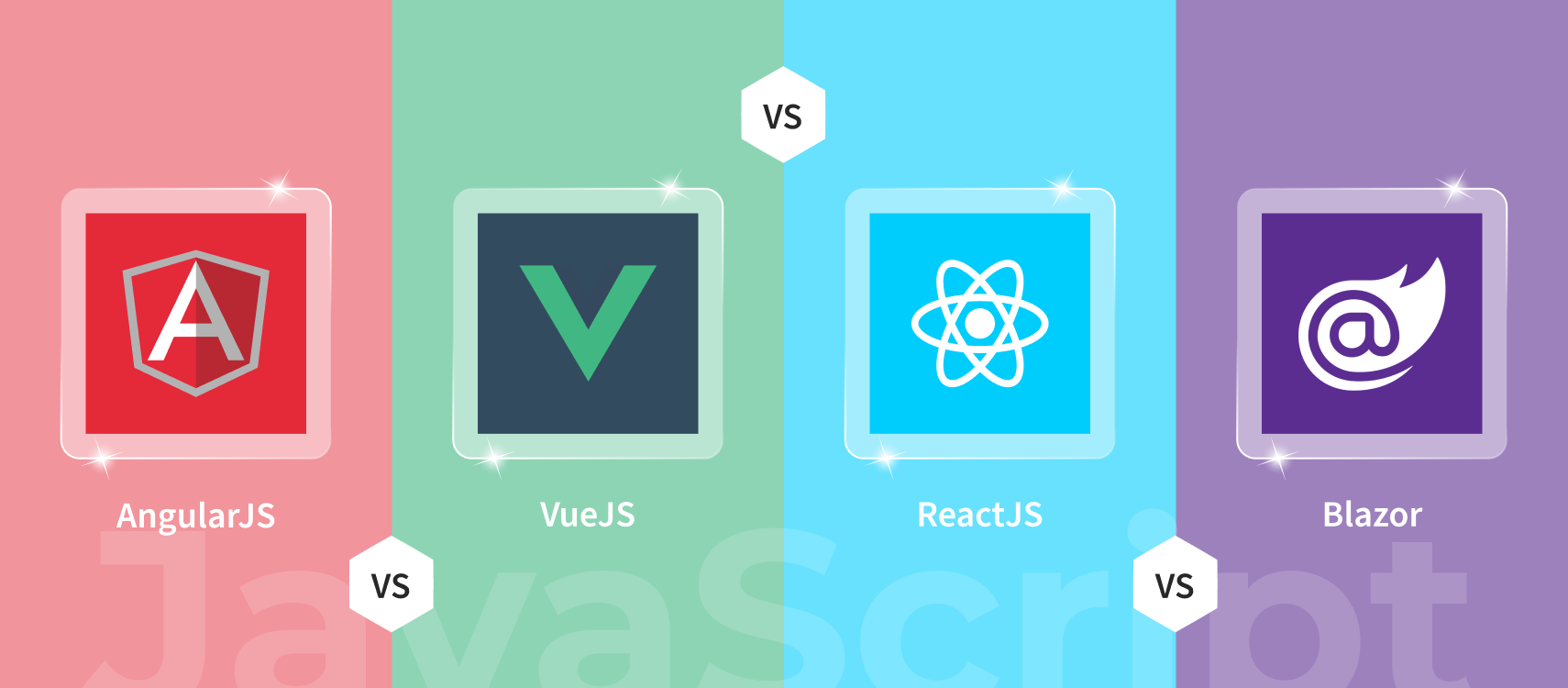Table of Contents
- React.js
- Angular
- Vue.js
- Blazor
- Ending Notes
In today’s rapidly evolving web development landscape, choosing the right framework is essential for building robust and efficient applications. React.js, Angular, Vue.js, and Blazor are among the most popular frameworks, each with its unique features and capabilities.
In this blog post, we will conduct a comprehensive study of these frameworks, analyzing their strengths and weaknesses, helping you make an informed decision when selecting the ideal framework for your projects.
React.js
React.js, developed by Facebook, is a widely adopted JavaScript library for building user interfaces. Its core philosophy revolves around creating reusable UI components, providing developers with flexibility and ease of use. Let’s delve into React.js’s strengths and weaknesses.
Strengths
Virtual DOM:
One of React’s biggest advantages is its Virtual DOM implementation. This feature allows React to efficiently update only the necessary parts of the DOM, resulting in improved performance and responsiveness.
Component-Based Architecture:
React’s component-based architecture promotes reusability, maintainability, and scalability. Developers can encapsulate UI elements into reusable components, making the codebase organized and easier to manage.
Large Community and Ecosystem:
React has a vast community of developers contributing to numerous open-source libraries, tools, and extensions. This vibrant ecosystem ensures continuous updates, support, and readily available solutions to common problems.
Strong Industry Adoption:
React is widely used by prominent tech companies, ensuring its stability and long-term support. This adoption also means an abundance of resources and tutorials for learning and troubleshooting.
Weaknesses
Learning Curve:
React’s steep learning curve can be intimidating for beginners, especially those new to JavaScript and front-end development. Understanding concepts like JSX and state management may require additional time and effort.
Lack of Opinionated Structure:
React doesn’t enforce a specific project structure or architecture, which can lead to inconsistencies in large projects and require careful planning for maintaining code quality.
Angular
Angular, developed and maintained by Google, is a full-fledged TypeScript-based front-end framework. It offers an opinionated structure and various built-in tools for building complex applications. Let’s explore its strengths and weaknesses.
Strengths
Two-way Data Binding:
Angular’s powerful two-way data binding simplifies the synchronization between data models and UI elements, reducing the need for manual DOM manipulation.
Complete Framework:
Angular provides a comprehensive set of tools, including a robust CLI, routing, dependency injection, and more. This all-in-one approach streamlines development and ensures consistent practices across projects.
TypeScript Integration:
Angular is built on TypeScript, adding static typing to JavaScript, which results in better code maintainability and enhanced tooling support.
Strong Community and Enterprise Adoption:
Angular has gained popularity in enterprise-level applications, with a large community actively contributing to the framework’s growth and stability.
Weaknesses
Steeper Learning Curve:
Similar to React, Angular’s learning curve can be steep, especially for developers new to TypeScript or more complex application architectures.
Performance Overhead:
Angular’s comprehensive feature set and complex architecture can sometimes lead to a higher performance overhead compared to lighter frameworks like Vue.js.
Vue.js
Vue.js, often dubbed the progressive framework, is designed to be incrementally adoptable, making it an excellent choice for both small projects and large-scale applications. It combines the best features of React and Angular while maintaining a minimalistic footprint. Let’s explore its strengths and weaknesses.
Strengths
Approachable Learning Curve:
Vue.js is known for its easy-to-understand syntax and straightforward documentation, making it highly accessible for beginners. Developers with prior experience in HTML, CSS, and JavaScript can quickly get started.
Versatility:
Vue.js allows developers to start small and incrementally add complexity as needed, making it a versatile framework suitable for both simple websites and complex applications.
Performance:
Vue.js boasts an impressive performance, thanks to its Virtual DOM implementation and smart update mechanisms. It efficiently updates the DOM when the underlying data changes, resulting in a smoother user experience.
Ecosystem and Community:
Although not as extensive as React’s or Angular’s, Vue.js has a thriving community that actively maintains various libraries, plugins, and tools.
Weaknesses
Smaller Community:
Vue.js, while growing rapidly, still has a smaller community compared to React and Angular. This might translate to slightly fewer resources, support, and plugins.
Enterprise Adoption:
While Vue.js is gaining traction, it may not have the same level of enterprise adoption as React and Angular, which could impact long-term stability.
Blazor
Blazor is a relatively newer framework developed by Microsoft, allowing developers to build interactive web applications using C# instead of JavaScript. It leverages WebAssembly to run C# code directly in the browser, providing a unique approach to web development. Let’s explore its strengths and weaknesses.
Strengths
Code Sharing:
Blazor enables code sharing between the client and server, streamlining development and reducing redundancy. This shared code approach enhances maintainability and consistency.
Familiar Language:
Developers with experience in C# will find Blazor familiar and can leverage their existing skills to build web applications.
High Performance:
Blazor’s WebAssembly-powered approach enables it to achieve high performance and near-native execution speed for complex applications.
Weaknesses
Immaturity:
As a newer framework, Blazor might not have the same level of community support, third-party libraries, and resources as more established frameworks like React and Angular.
Browser Compatibility:
Although WebAssembly is supported in modern browsers, some older browsers might have limited or no support, which could limit the reach of Blazor-powered applications.
Ending Notes
React.js, Angular, Vue.js, and Blazor are all powerful web development frameworks, each with its strengths and weaknesses. When choosing a framework for your project, consider factors like project requirements, team expertise, community support, and long-term stability.
React.js is excellent for large-scale projects with a vast community and industry adoption, while Angular offers an all-in-one approach favored by enterprise-level applications. Vue.js stands out for its approachable learning curve and versatility, making it suitable for projects of all sizes. Blazor, with its unique C# and WebAssembly combination, shows promise for high-performance applications but may be better suited for projects where C# is the primary language.
Ultimately, the best framework choice will depend on the specific needs and goals of your development project, so take the time to evaluate each option carefully before making your decision. Happy coding!










